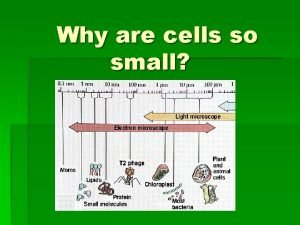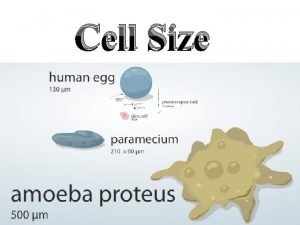Why are cells small Cells are typically small







- Slides: 7

Why are cells small?

Cells are typically small because of the ratio of surface area to volume. SA: V = 6 S 2/S 3 where S=length of one side We use cubes for simplicity of the math. In real life cells are more like spheres, but the concept remains the same.

● Surface area dictates amount of exchange across the cell membrane. ● The more surface area, the more exchange of nutrients and gases into the cell and wastes out of the cell through the cell membrane. MOLECULES INTO CELL… Glucose Oxygen gas MOLECULES OUT OF CELL… Carbon dioxide gas Urea (waste from metabolism)

Volume dictates the amount of materials that are needed or produced in the cytoplasm ● The more volume, the more nutrients and gases that are needed inside the cell for metabolic reactions. ● The more volume, the more waste that is produced that must leave the cell.

As a cell becomes too large…. . . the surface area to volume ratio A small cell becomes too small has more This means that the rate of transport across the surface area (either nutrients in or waste out) is too slow for the metabolic demands of the volume and the cell will not be able to function properly. surface area relative to the volume A large cell has less surface area relative to the volume

Some cells increase surface area to volume ratio by having: Long cellular extensions that increase surface area without large increase in volume (e. g. nerve cells) Thin, flat cell shapes that increase surface area without large increase in volume (e. g. red blood cells) Extensions of the cell membrane that increase surface area without large increase in volume (e. g. microvilli on small intestine cells)

Need more clarification? Watch this video.













